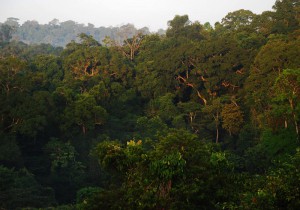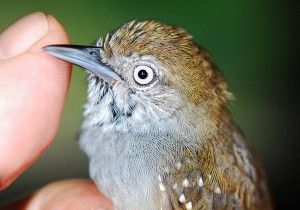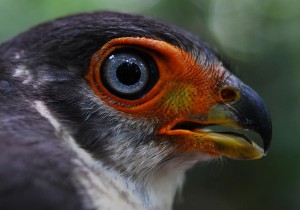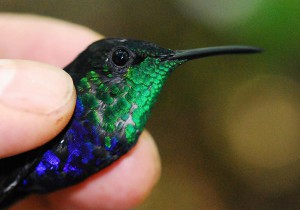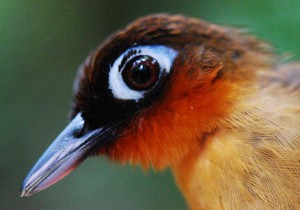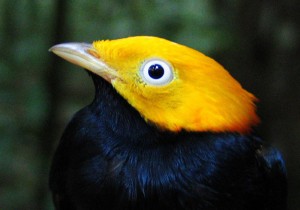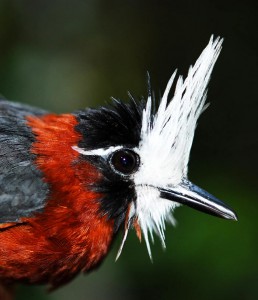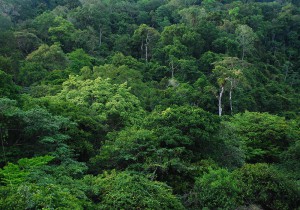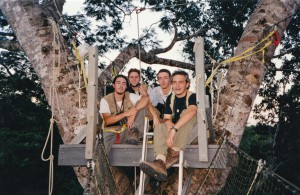We are interested in the evolutionary mechanisms that drive speciation in tropical regions, and we investigate the relative roles of geography and selection in driving lineage divergence. In Ecuador we have studied how populations of vary across space genetically and morphologically, and documented a case of ecomorphological adaptation in the wedge-billed woodcreeper (Glyphorynchus spirurus), showing that adaptation to different habitat types can take place even in the presence of gene flow. We are also working in French Guiana, where we are using DNA sequences and phenotypic differences to assess the degree of intraspecific variation in pan-Amazonian taxa, comparing populations there with those in Ecuador in order to determine whether some populations deserve to be designated as new species.
We are also collaborating with colleagues Javier Pérez-Tris and Michaël Moens at the Universidad Complutense de Madrid to study host-parasite relationships of Neotropical birds and three models of symbionts: protozoan blood parasites, feather mites and viruses causing skin lesions. We have sampled tens of species at the Nouragues Reserve in French Guiana and will soon publish results on levels of prevalence and parasitemia of various malaria protozoans. We are also designing experiments to assess the impact of malaria on bird activity and thus its potential influence on polination.
Related publications:
Truchado, D. A., A. Llanos-Garrido, D. A. Oropesa-Olmedo, B. Cerrada, P. Cea, M. A. J. Moens, E. Gomez-Lucia, A. Doménech, B. Milá, J. Pérez-Tris, D. Cadar, L. Benítez. 2020. Comparative metagenomics of Palearctic and Neotropical avian cloacal viromes reveal geographic bias in virus discovery. Microorganisms, 8: 1869.
Truchado, D. A., J. M. Diaz-Piqueras, E. Gomez-Lucia, A. Doménech, B. Milá, J. Pérez-Tris, J. Schmidt-Chanasit, D. Cadar, L. Benítez. 2019. A novel and divergent Gyrovirus with unusual genomic features detected in wild passerine birds from a remote rainforest in French Guiana. Viruses, 11(12):1148.
Moens, M., J. Pérez-Tris, B. Milá, L. Benítez. 2017. The biological background of a recurrently emerging infectious disease: prevalence, diversity and host specificity of Avipoxvirus in wild Neotropical birds. Journal of Avian Biology, 48:1-6.
Milá, B., E. S. Tavares, A. Muñoz Saldaña, T. B. Smith, J. Karubian, A. J. Baker. 2012. A trans-Amazonian screening of mtDNA reveals deep intraspecific divergence in forest birds and suggests a vast underestimation of species diversity. PLOS ONE, 7(7): e40541.
Milá, B., R. K. Wayne, P. S. Fitze and T. B. Smith. 2009. Divergence with gene flow and fine-scale phylogeographic structure in the wedge-billed woodcreeper Glyphorynchus spirurus, a Neotropical rainforest bird. Molecular Ecology, 18:2979-2995.
Thomassen, H. A., W. Buermann, B. Milá, C. H. Graham, S. E. Cameron, C. J. Schneider, J. P. Pollinger, S. Saatchi, R. K. Wayne and T. B. Smith. 2009. Modeling environmentally associated morphological and genetic variation in a rainforest bird, and its application to conservation prioritization. Evolutionary Applications, 3(1):1-16.
Buermann, W., S. Saatchi, T. B. Smith, B. R. Zutta, J. A. Chaves, B. Milá and C. H. Graham. 2008. Predicting species distributions across the Amazonian and Andean regions using remote sensing data. Journal of Biogeography 35(7):1160-1176.

